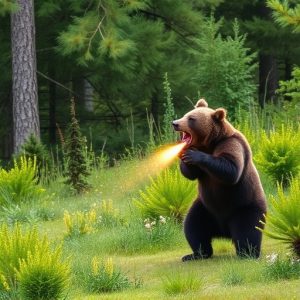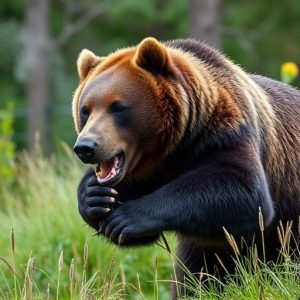Optimizing Bear Spray Defense: Alaska Fog Pattern Test Results
In Alaska's diverse terrain, understanding the Bear Spray Fog Pattern Test is crucial for outdo…….
In Alaska's diverse terrain, understanding the Bear Spray Fog Pattern Test is crucial for outdoor safety. This test simulates bear encounters, assessing the range and coverage of bear spray, which is vital for selecting the right type based on activity and location. The test optimizes droplet size and duration to create a dense cloud that protects sensitive areas from bears. Coverage is influenced by wind speed, direction, and terrain—gentle breezes aid distribution while strong winds can drift spray away. Proper usage includes understanding range, carrying securely, checking for damage, and practicing application targeting face and chest; regular maintenance ensures effectiveness.
In Alaska’s vast wilderness, understanding the guard bear spray fog pattern test is crucial for safety. This article delves into the science behind bear spray distribution, exploring factors that influence its effective coverage area. We’ll guide you through the best practices for using and maintaining bear spray, ensuring your safety during outdoor adventures in light of the unique challenges Alaska presents. Learn about the Bear Spray Fog Pattern Test to make informed decisions in bear country.
- Understanding Bear Spray Fog Pattern Test: Why It Matters in Alaska
- The Science Behind Bear Spray Fog Distribution
- Factors Influencing Effective Coverage Area
- Best Practices for Using and Maintaining Bear Spray in Alaska's Wilderness
Understanding Bear Spray Fog Pattern Test: Why It Matters in Alaska
In Alaska, understanding the bear spray fog pattern test is crucial for ensuring safety while outdoors. This test evaluates how effectively bear spray dissipates and reaches targets, which is vital as it can mean the difference between a close encounter and a safe retreat. The Bear Spray Fog Pattern Test simulates real-world scenarios where bears might be encountered, assessing the spray’s range, coverage, and ability to disperse quickly.
Given Alaska’s diverse terrain and weather conditions, this test becomes even more critical. It helps users choose the right bear spray for their specific needs, whether they’re hiking in dense forests or camping in open fields. By understanding the fog pattern, individuals can make informed decisions about when and how to use bear spray, enhancing their chances of a safe and enjoyable outdoor experience in the Last Frontier.
The Science Behind Bear Spray Fog Distribution
The effectiveness of bear spray is closely tied to its distribution pattern, with fog being a key element in achieving optimal coverage. Bear spray fog distribution involves understanding how the aerosol particles disperse and settle after deployment. Scientific tests have shown that the ideal fog pattern should create a dense cloud of microscopic droplets that remain suspended in the air for an extended period, allowing for maximum contact with potential bear threats.
These tests, known as Bear Spray Fog Pattern Tests, focus on factors such as droplet size, spray duration, and wind conditions to determine the most efficient means of protection. The goal is to create a fog that blankets the area around the user, providing a protective barrier against bears without requiring direct contact with the animal. This strategic approach ensures that the spray reaches sensitive areas like eyes, nose, and gills, disabling the bear’s ability to attack or persistently chase the individual.
Factors Influencing Effective Coverage Area
The effective coverage area of bear spray fog is influenced by several key factors, as determined through rigorous Bear Spray Fog Pattern Tests. One significant factor is the wind speed and direction; a gentle breeze can help distribute the spray evenly, increasing the protected area. Conversely, strong winds may cause the spray to drift away from the intended target, reducing its effectiveness.
Another crucial element is the terrain. In open, flat areas, the fog pattern tends to spread out more broadly, offering better protection. However, in rugged terrain with numerous trees or rocky outcrops, the spray can be deflected or absorbed, potentially limiting its range. Understanding these factors is essential for individuals venturing into bear country to ensure their safety and make informed decisions regarding bear spray usage.
Best Practices for Using and Maintaining Bear Spray in Alaska's Wilderness
When using bear spray in Alaska’s wilderness, adhering to best practices is crucial for safety and effectiveness. Start by understanding the bear spray fog pattern test results; this will give you insights into the spray’s range and coverage. Always carry bear spray in an easily accessible, secure container, ensuring it remains intact and unexpired.
Before encountering a bear, ensure your spray is ready for use by checking the can for any damage or discrepancies. Practice proper application techniques, aiming for the face and chest of the bear, which are critical areas per the Bear Spray Fog Pattern Test results. Regularly maintain and inspect your bear spray, storing it appropriately between uses to guarantee its longevity and viability in case of an emergency.
Understanding the bear spray fog pattern test is paramount for anyone venturing into Alaska’s wilderness. By grasping the science behind fog distribution, identifying factors that influence coverage area, and adhering to best practices for usage and maintenance, individuals can significantly enhance their safety while outdoor exploring. The Bear Spray Fog Pattern Test serves as a crucial guide, ensuring users are prepared to navigate Alaska’s unique environment with confidence and resilience against potential bear encounters.


